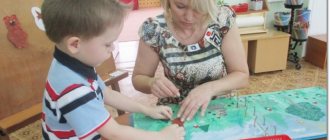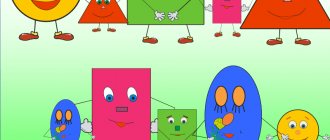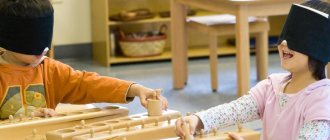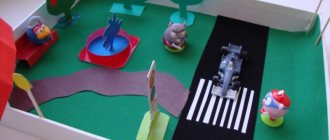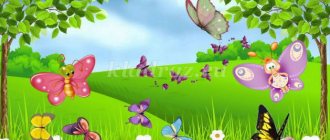Tasks and methods of forming temporary representations
The main tasks for developing temporary representations are:
— formation of primary practical orientation in time;
- formation of a sense of time;
— familiarization with individual “temporary” standards;
— formation of initial ideas and concepts about some properties of time (objectivity, periodicity, simultaneity).
A simplified and adapted to the psychological characteristics and level of knowledge of preschool children, the definition of the concept “time” is what determines the change of natural phenomena, various events and the duration of the existence of something in us and around us becomes the result of the material:
- Time units: basic (day, week, month, year), derivatives (hour, minute, second).
Children's acquaintance with units of time measurement should be carried out in a system of strict consistency, where knowledge of some time intervals, the ability to define and measure them, would serve as the basis for familiarization with subsequent ones and would reveal to children the essential characteristics of time: fluidity, continuity and irreversibility.
2. Instruments for measuring time: watches (hourglass, mechanical, electronic).
3. Periodic, including seasonal natural phenomena and periodic (routine) events of everyday life.
4. Properties of time.
To measure time, regularly repeating phenomena are accepted: the change of day and night, the change of lunar phases, the change of season, caused by the daily rotation of the globe around its axis, the movement of the Moon around the Earth, and the movement of the Earth around the Sun.
Deepening, clarifying and consolidating the correct understanding and use of tense terms is carried out in classes using handout didactic material.
Starting from the fourth year of life, the formation of temporary representations is carried out in mathematics classes. The main methods and techniques for this are: observations, conversations, explanations, demonstrations, artistic expression, exercises, training, didactic games, etc. Children develop knowledge about the parts of the day and the ability to distinguish between them in the process of specific observation. The teacher must ensure that children use the words: “morning”, “day”, “evening”, “night”.
When teaching children to recognize parts of the day, it is sufficient to limit themselves to correlating the correct designation of each part of the day with the corresponding period of time and teach them to determine this period by their characteristic activities and external signs.
In the learning process, it is necessary to include to a greater extent objective indicators for recognizing parts of the day - the position of the sun at different times of the day, different levels of illumination of the earth and sky, as well as the different colors of everything around us at different parts of the day.
After children have learned to identify parts of the day based on various activities, their attention should be focused on indicators that symbolize time (position of the sun, degree of illumination of the earth, color of the sky, etc.). For these purposes, observations of these phenomena during walks are organized.
Children should be taught to distinguish and correctly use the words: “today,” “tomorrow,” “yesterday.” You can use the following exercises with specific, understandable content: “Today we have a math lesson. What was your activity yesterday? Tomorrow we will have a drawing lesson. What song did you sing in music class yesterday?”
The concept of “fast” and “slow” is formed in children in the process of direct observations of their actions and the actions of adults, animals, birds, etc.
In order to consolidate acquired knowledge, various exercises and didactic games are used, in which visual aids are widely used. Children are organized to look at paintings, illustrations, photographs, which, through the content of the activity depicted in the picture and some objective indicators, help the child determine and name the time.
Particular attention is paid to learning to distinguish between parts of the day, observing not only the work of people, but also the position of the sun. Through observations and comparisons, children are explained the concepts of “vault of heaven,” “sunset,” “horizon,” and are given the opportunity to make sure that the sun moves across the vault of heaven throughout the day. During the day, compared to morning and evening, the sun rises above the horizon, and shadows from objects become short. The period of the day when the sun is high in the sky and children are playing in the garden is called “noon”, this is the middle of the day. Based on direct observations and examination of corresponding reproductions of paintings, children of this age group are introduced to the phenomena: “sunset”, “sunrise”, “twilight”, “dawn” and explain why they say about these periods of the day: “dusk”, “dawn” " Children are explained that the total duration of morning, day, evening and night is a day. When children learn the concept of “day,” a number of techniques are used: showing pictures, asking questions, playing games, etc.
Mastering temporary relationships by preschool children
1.Analysis of programs
In domestic pedagogy, the problem of familiarizing children with space and time is reflected in the works of E.N. Vodovozova, A.M. Leushina, V.A. Sukhomlinsky, T.A. Richterman, K.D. Ushinsky and others.
K.D. Ushinsky, developing theoretical and methodological approaches to the development of speech in children, constantly emphasized the need to teach children to “distinguish between prepositions in time.” In his opinion, children should be explained that to distinguish time “we use the names of months, days, weeks, count hours, numbers, years.” K.D. Ushinsky suggests introducing children of the 7th year of life to the concepts: day, week, month, year, as well as the millennium and concepts that determine the age of people: baby, child, youth, youth, girl, man, woman, old man, old woman.
E.N. Vodovozova was interested in the question of the amount of knowledge about time and space for preschoolers. She believed that it was enough for children to know the order of the seasons, the sequence of days of the week, and its quantitative composition; understand the words “younger”, “older”. Proposing to carry out observations of the position of the sun, E.N. Vodovozova in this regard proposed to give children the concepts of “noon”, “twilight”, and introduce them to the cardinal points.
In the studies of L.A. Efimova, who studied the problems of developing ideas about the depth of historical time in children of primary school age, time is considered as a special stimulus. It shows the connection between the formation of historical and temporal ideas about time in children with their life experience; emphasizes the role of the first signaling system in the development of ideas in children, as well as mastery of words - children begin to be distracted from the present (today), thinking about the past (yesterday). Taking into account the psychological characteristics of children of this age, the author identifies the main methods of work: comparisons of clarity (much attention is paid to the use of clarity of paintings, drawings, portraits), chronology and movement, for example, the word “distant past” is a signal of temporal connections previously developed: “history”, “excavation”, “tribe”, “king”, etc.
A.M. Leushina made a great contribution to the development of problems in the mathematical development of preschool children. The concept of the formation of quantitative concepts, developed by her in the 40s, was significantly supplemented in the 60s and 70s through scientific, theoretical and methodological development of the problem of the development of spatio-temporal concepts in preschoolers. Subsequently, under the leadership of A.M. Leushina, content and methods were developed for the formation of spatial and temporal concepts in children, teaching the measurement of objects, body weight, ensuring the mental and comprehensive development of children. Preschoolers' assimilation of the content of abstract knowledge was carried out mainly through the assimilation of practical actions.
Developed by A.M. Leushina’s concept was implemented in the Model “Program of Education and Training in Kindergarten” (1987).
The theoretical principles, methodological recommendations and experience of M.I. Vasilyeva’s work on the development of time orientation in children of senior preschool age (late 50s - early 60s) are interesting. In the work of M.I. Vasilyeva, a position is formulated on the role of time in the regulation of a child’s behavior and activity. The result of the work is that children began to spend time more economically on performing household processes. The effect of children's development included both an intellectual and a moral component. The positive results achieved, the author emphasizes, became possible in the context of targeted work to develop a sense of time in children.
T.A. Museibova in her work points out that preschool age can be characterized as the initial stage of the development of a child’s “theoretical” knowledge of time orientations and the formation of the unity of the sensory and logical relationship of time. In his work, the author relies on the psychological foundations of the perception of time, studied by B.G. Ananyev, who points out that the relationship of time appears in two main forms, which are also stages of cognition: direct (sensory-figurative) and indirect (logical-conceptual). The interconnection and unity of these basic forms of reflection is also revealed in the field of reflection of spatio-temporal relations of objective reality. T.A. Museyibova argues that work on developing time orientation in children in kindergarten should not have a highly specialized purpose, but serve as an effective means of developing their personality as a whole.
At the end of the 70s, R. Chudnova proposed a system for teaching time orientation. When developing knowledge about the seasons in the classroom, the author suggests making extensive use of pictures and verbal material: stories, poems, riddles, proverbs, and also to improve knowledge about the seasons, she developed visual models “Parts of the day”, “Days of the week”, “Seasons” " These models are symbols of the year and seasons. When using these models and illustrated material, the author takes into account the age-related psychological characteristics of children.
T.D. Richterman also reveals the main features of children’s perception of time, clarifies tasks, and offers interesting work techniques. However, she offers an introduction to the parts of the day on a visual basis - the use of pictures reflecting children’s activities in different parts of the day, then offers landscape pictures, where children are guided by the main natural indicators: the color of the sky, the position of the Sun in the sky, the degree of illumination of the day. Next, she advises switching to the conventions of landscape pictures using a color model, where each time of day is indicated by a certain color, and also recommends interesting techniques for working with this model. As a generalization of knowledge about time, the author proposes to introduce children of senior preschool age to the calendar as a system of time measures.
E. Shcherbakova studied the formation in preschoolers of time ideas and concepts, such as day, week, year and some properties of time - one-dimensionality, fluidity, irreversibility, periodicity; as well as primary practical orientation in time.
N. Lokot continued the research of E. Shcherbakova and proposed some improvement in three-dimensional models for the formation of temporary representations, consisting in the fact that the spiral, unfamiliar to preschoolers, is replaced by a multilayer surface. Such a model, N. Lokot believes, creates a visual image of the transition of the night of yesterday into the morning of today, and the night of the current day into the morning of tomorrow. In a similar way, N. Lokot suggests making a model of the week and year, using flat circular models of the week and year as a basis.
In the 90s, the works of E. Serbina, T.I. Erofeeva, L.I. Pavlova, V.N. Novikova and others were of interest. Thus, E. Serbina believes that education should not destroy the naturalness of children’s lives, points to the importance of introducing children to mathematical concepts in real life on ordinary, rather than specially made objects, so that the child sees that mathematical concepts describe the real world. She emphasizes that when planning the educational process, it is necessary to include mathematical content in the context of traditional activities: games, drawing, labor, singing, movement to music.
In the 90s, T.D. Richterman continued research work on the problem of the development of ideas about time, namely, he identified the peculiarities of preschoolers’ understanding of time sequence. She points out that in older preschool age such a phenomenon as “operator time” is already recognized by the child. “Operator time” is understood by her as an awareness of the parallelism of events in time, helping children to better understand the universal nature of time.
T.I. Erofeeva, L.N. Pavlova, V.I. Novikova in their research work show the importance of the sensory experience of a preschooler, the principle of clarity in teaching children mathematics.
2. Compilation of a comparative table of content by age groups in programs for the education and training of preschool children
| Age | Training content |
| Junior group (3-4 years) | Children's ideas about such periods of time as morning, afternoon, evening and night are formed. Children distinguish parts of the day by changes in the content of their activity, as well as the activity of the adults around them during these periods of time. A precise daily routine, strictly established times for children to get up, morning exercises, breakfast, classes, etc. create real conditions for forming an idea of the parts of the day. The teacher names a period of time and lists the children’s activities corresponding to it: “It’s morning. We did the gymnastics, washed ourselves and now we’ll have breakfast.” Or: “We already had breakfast and worked out. It's already daytime. We'll have lunch soon." The child is asked, for example: “It’s morning. What are you doing in the morning? When you get up?" and so on. Children look at pictures and photographs depicting the activities of children and adults at different periods of time. Gradually, the words morning, day, evening, night are filled with specific content and acquire emotional overtones. Children begin to use them in their speech. |
| Middle group (4-5 years old) | The teacher clarifies children's understanding of the parts of the day, connecting their names with what children and adults close to them do in the morning, afternoon, evening, and night. Time orientation develops in children mainly in everyday life. It is important that it is based on a strong sensory foundation. A conversation is held with children in order to clarify their understanding of the day. The conversation can be structured something like this: first, the teacher asks the children to tell what they did before they came to kindergarten, what they did in the morning in kindergarten, what they do in the afternoon in kindergarten, etc. He clarifies and generalizes what children do it in each period of the day. And in conclusion he says that morning, day, evening and night are parts of the day. Temporary concepts “today”, “tomorrow”, “yesterday” are relative; children find it difficult to learn them. Therefore, it is necessary to use the words today, tomorrow, yesterday as often as possible and encourage children to do this. The teacher constantly turns to the children with questions: “When did we draw? What did we see today (yesterday)? Where will we go tomorrow? The meaning of words is quickly and slowly revealed using specific examples. The teacher draws the children's attention to the degree of speed of their movements in games (“The train goes slowly, then faster and faster”). While dressing, he praises those who dress faster and blames those who are slow; on walks compares the speed of a pedestrian and a cyclist, a car and a train, a caterpillar and a beetle. |
| Senior group (5-6 years old) | They consolidate and deepen the understanding of such time periods as morning, afternoon, evening and night. The names of the parts of the day are associated not only with the specific content of the activities of children and the adults around them, but also with more objective indicators of time - natural phenomena (morning - the sun rises, becomes lighter and lighter, etc.). The teacher talks with the children about what, when and in what sequence they and the adults around them do during the day, about the impressions of early morning, noon, and evening. He reads poems and stories with appropriate content to the children. |
| Preparatory group (6-7 years old) | They consolidate knowledge about such periods of time as morning, day, evening, night, week, give an idea of the months, and the children remember their names. Knowledge of time standards and the ability to establish temporary relationships contribute to children’s awareness of the sequence of events and the cause-and-effect relationships between them. Orientation in time should be based on a solid sensory basis, i.e., the experience of the duration of time in connection with the implementation of various activities, differently emotionally colored, as well as observations of natural phenomena and events of social life. Of great importance is how often children use the names of periods of time and measures of time in their speech. They continue to consolidate knowledge about the parts of the day and their duration. Children are also reinforced with the idea that the day, which people usually call the word day, is replaced by one another and has its own names; 7 days make up a week. The sequence of days of each week is always the same: Monday, Tuesday, etc. Every morning, children name the current day, as well as the previous and subsequent ones. It is important to encourage children as often as possible to establish temporary relationships, to use the words tomorrow, today, yesterday, first, then, before, after, before, before this, after that. When composing stories from experience and retelling, the teacher monitors the exact transmission of the sequence of events and explains the meaning of time relationships. This is essential for understanding both the logic of temporal relationships and the events themselves that children observe or talk about. The use of verbal game exercises “Days of the week”, “Continue!”, “On the contrary” is even more important. Children complete the phrase started by the teacher, select words of opposite meaning (morning - evening, first - then, quickly - slowly, etc.), determine what is longer: a day or a week, a week or a month, a month or a year. Children in the preparatory group are introduced to the name of the current month. They gradually remember the names of the months and their order. Reading the book “Twelve Months” by S. Ya. Marshak contributes to quick memorization. It is important to instill in children a sense of time, that is, to develop a perception of the duration of time periods and an understanding of the irreversibility of time. |
3. Development of diagnostics for the development of time representations by preschoolers in the preparatory group (diagnostic table + tasks according to the table to identify the level of knowledge)
| Diagnostic method | Content |
| Observation | observing children's activities in the classroom |
| Conversation | An introductory conversation with teachers, psychologists working with these children, and parents; Direct conversation with students in order to identify the level of development of temporal concepts |
| Analysis of activity products | Study of drawings, applications, independent work |
In the process of examining the ability to navigate in time, the following points are highlighted:
1. Do children know the seasons (do they show these seasons in pictures, name them or just show them, can they verbally describe the signs of the seasons, do they know the sequence of the seasons).
2. Do they know how to identify and name the parts of the day, do they know their sequence (using two types of pictures: depicting actions in different parts of the day and natural phenomena (the position of the Sun and Moon at different times of the day), it is noted which pictures better identify the parts of the day and what part of the day they know best).
3. What are the days of the week called, do they know their sequence.
The examination allows us to identify the level of development of time concepts and makes it possible to more accurately determine the main directions of frontal work and individual work.
Features of the formation of temporary representations in different age groups - older age
Children in the older group consolidate and deepen their understanding of units and some features of time. The name of the parts of the day is associated not only with the specific content of the activities of children and adults who surround them, but also with more objective indicators of time - natural phenomena. Children get acquainted with the seasons, the names of the days of the week, determine what day of the week was yesterday, what it is today, what it will be tomorrow.
In work, it is necessary to widely use such methods as: observations, conversations, reading, retelling fairy tales, poems, looking at paintings, photographs, didactic games and exercises, focusing on the familiar periodicity of day and night.
Older preschoolers need to form conscious concepts about the day. During the learning process, attention is paid to the cyclical change of day and night. Nature itself suggested to people a way to divide time according to the principle: day and night - day. To correctly understand the day, children must realize that the day can be divided into four parts: morning, afternoon, evening, night.
Older preschoolers distinguish and name parts of the day, focusing on sunrise and sunset. In the process of observing natural phenomena, they learn the concepts: at dawn, at dusk, at noon, at midnight. To form these ideas, the teacher uses, first of all, observations, looking at plot paintings, as well as reading fiction and learning poems.
Familiarization with the days of the week already in the senior group should be combined with the formation of knowledge about the week as a measure of working time. Focusing on the fact that people work five days a week and rest two days helps to understand the quantitative composition of the number 7 (days of the week).
Experience shows that not all days of the week are remembered equally easily and quickly. The best days to remember are Sunday, Saturday and Monday.
In addition, in the older group, work is being done to develop children’s ideas about the seasons. In this case, pictures and verbal material are widely used: stories, fairy tales, poems, riddles, proverbs.
In the older group, the teacher develops a “sense of time”, an understanding of its meaning in people’s lives, and the irreversibility of time. In this group there is an opportunity to familiarize children with a three-dimensional model of time, by which they can understand the continuity, irreversibility, and symmetry of time.
